Effects of Deposition Pressure on the Microstructural and Tribological Properties of CrAgCeN Coatings Prepared by Magnetron Sputtering
Abstract
:1. Introduction
2. Materials and Methods
2.1. Coating Deposition
2.2. Coating Characteristics
3. Results
3.1. Structural Characterization
3.2. Mechanical Properties
3.3. Friction and Wear
3.4. Mechanism of the Wear Protection and Morphology of the Worn Surfaces
4. Conclusions
- (1)
- The CrAgCeN coatings presented a FCC structure and the characteristic diffraction peaks of CrN, Cr2N, Ag, AgN3 and Ce via the XRD analysis.The grain size of the coating first decreased and then increased with increasing deposition pressure.
- (2)
- The hardness of the CrAgCeN coating also increased and then decreased with increasing deposition pressure. The maximum hardness (14.2 GPa) was reached at a deposition pressure of 0.6 Pa. Meanwhile, the elastic modulus of the coating gradually decreased with increasing deposition pressure. The hardness of the coating was affected by the strengthening of Ce fine grains and the soft Ag phase. The decrease in the elastic modulus was mainly attributable to the Ag phase, which has an intrinsically low elastic modulus.
- (3)
- The average friction coefficient and wear rate of the thin CrAgCeN coatings first decreased and then increased with increasing deposition pressure. The average friction coefficient and wear rate were minimized at a deposition pressure of 0.6 Pa, reaching 0.391 and 3.2 × 10−7 mm3/(N·m), respectively.
- (4)
- The addition of rare earth Ce has better wear resistance than that of the coating with free-Ce. It provides a reference for the preparation of multi-element ceramic matrix coating containing rare earth elements with excellent comprehensive performance. By further adjusting the magnetron sputtering process parameters, the prepared CrAgCeN coating can potentially be used in industrial fields such as machining tools and aeroengine blades.
Author Contributions
Funding
Institutional Review Board Statement
Informed Consent Statement
Conflicts of Interest
References
- Kovačević, L.; Terek, P.; Miletić, A.; Kukuruzović, D.; Škorić, B.; Panjan, P. Industrial evaluation of duplex PVD hard coatings for HPDC. J. Braz. Soc. Mech. Sci. 2018, 40, 271. [Google Scholar] [CrossRef]
- Erdemir, A.; Voevodin, A.A. Nanocomposite Coatings for Severe Applications. In Handbook of Deposition Technologies for Films and Coatings, 3rd ed.; William Andrew: Norwich, NY, USA, 2010; pp. 679–715. [Google Scholar]
- Zhang, J.; Li, Z.; Wang, Y.; Zhou, S.; Wang, Y.; Zeng, Z.; Li, J. A new method to improve the tribological performance of metal nitride coating: A case study for CrN coating. Vacuum 2020, 173, 109158. [Google Scholar] [CrossRef]
- Krella, A. Resistance of PVD Coatings to Erosive and Wear Processes: A Review. Coatings 2020, 10, 921. [Google Scholar] [CrossRef]
- Mamoun Fellah, L.A.M.A.; Said Mechacheti, M.Z.T.A. Characterisation of R.F. magnetron sputtered Cr-N, CrZrN and ZrN coatings. Trans. IMF 2017, 95, 261–268. [Google Scholar] [CrossRef] [Green Version]
- Yao, H.S.; Su, L.Y.; Kao, H.W. Performance of nanolayer CrN/Ag coated cutting tools. Surf. Eng. 2011, 11, 180–189. [Google Scholar] [CrossRef]
- Kuppusami, P.; Elangovan, T.; Murugesan, S.; Thirumurugesan, R.; Khan, S.; George, R.P.; Ramaseshan, R.; Divakar, R.; Mohandas, E.; Mangalaraj, D. Microstructural, nanomechanical and antibacterial properties of magnetron sputtered nanocomposite thin films of CrN/Cu. Surf. Eng. 2012, 28, 134–140. [Google Scholar] [CrossRef]
- Wo, P.C.; Munroe, P.R.; Jiang, Z.; Zhou, Z.; Li, K.Y.; Xie, Z. Enhancing toughness of CrN coatings by Ni addition for safety-critical applications. Mater. Sci. Eng. A 2014, 596, 264–274. [Google Scholar] [CrossRef] [Green Version]
- Ou, Y.X.; Ouyang, X.P.; Liao, B.; Zhang, X.; Zhang, S. Hard yet tough CrN/Si3N4 multilayer coatings deposited by the combined deep oscillation magnetron sputtering and pulsed dc magnetron sputtering. Appl. Surf. Sci. 2020, 502, 144168. [Google Scholar] [CrossRef]
- Trindade, B.; Li, W.Z.; Fernandes, F.; Cavaleiro, A. Effect of Nb target power on the structure, mechanical properties, thermal stability and oxidation resistance of Cr–Al–Nb–N coatings. Surf. Coat. Technol. 2016, 285, 270–277. [Google Scholar] [CrossRef]
- Jalaa, A.; Mohamad, S.; Bassam, A. Investigation of Pressure Effect on Structural, Mechanical Properties and Corrosion Performance of CrN Thin Films. Silicon 2019, 10, 2489–2495. [Google Scholar]
- Vite, M.; Moreno-Ríos, M.; Hernández, E.A.G.; Laguna-Camacho, J.R. A study of the abrasive resistance of sputtered CrN coatings deposited on AISI 316 and AISI H13 steel substrates using steel particles. Wear 2011, 271, 1273–1279. [Google Scholar] [CrossRef]
- Alexander, R.; Elisabeth, R.; Federico, S. CrN coatings deposited by magnetron sputtering: Mechanical and tribological properties. Dyna-Bilbao 2015, 82, 147–155. [Google Scholar]
- Zhang, X.; Tian, X.; Zhao, Z.; Gao, J.; Zhou, Y.; Gao, P.; Guo, Y.; Lv, Z. Evaluation of the adhesion and failure mechanism of the hard CrN coatings on different substrates. Surf. Coat. Technol. 2019, 364, 135–143. [Google Scholar] [CrossRef]
- Kutschej, K.; Mitterer, C.; Mulligan, C.P.; Gall, D. High-Temperature Tribological Behavior of CrN-Ag Self-lubricating Coatings. Adv. Eng. Mater. 2006, 8, 1125–1129. [Google Scholar] [CrossRef]
- Zhou, F.; Ma, Q.; Zhang, M. Comparison of tribological properties of CrN, CrTiN and CrTiBN coatings sliding against SiC and SUS440C balls in water. Appl. Physics. A Mater. Sci. Process. 2020, 126, 796. [Google Scholar] [CrossRef]
- Li, H.; Liu, Z.; Li, J.; Huang, J.; Kong, J.; Wu, Q.; Xiong, D. Effects of Hf addition on the structure, mechanical and tribological properties of CrN film. Surf. Coat. Technol. 2020, 397, 126067. [Google Scholar] [CrossRef]
- Kong, J.; Hou, T.; Wang, Q.; Yin, L.; Zhou, F.; Zhou, Z.; Li, L.K. Influence of titanium or aluminum doping on the electrochemical properties of CrN coatings in artificial seawater. Surf. Coat. Technol. 2016, 307, 118–124. [Google Scholar] [CrossRef]
- Sliney, H.E. Solid lubricant materials for high temperatures a review. Tribol. Int. 1982, 15, 303–315. [Google Scholar] [CrossRef] [Green Version]
- Mulligan, C.P.; Gall, D. CrN–Ag self-lubricating hard coatings. Surf. Coat. Technol. 2005, 200, 1495–1500. [Google Scholar] [CrossRef]
- Mulligan, C.P.; Papi, P.A.; Gall, D. Ag transport in CrN/Ag nanocomposite coatings. Thin Solid Films 2012, 520, 6774–6779. [Google Scholar] [CrossRef]
- Papi, P.A.; Mulligan, C.P.; Gall, D. CrN–Ag nanocomposite coatings: Control of lubricant transport by diffusion barriers. Thin Solid Films 2012, 524, 211–217. [Google Scholar] [CrossRef]
- Mulligan, C.P.; Blanchet, T.A.; Gall, D. CrN–Ag nanocomposite coatings Tribology at room temperature and during a temperature ramp. Surf. Coat. Technol. 2010, 204, 1388–1394. [Google Scholar] [CrossRef]
- Sahul, M.; Smyrnova, K.; Haršáni, M.; Čaplovič, L.; Pogrebnjak, A.; Sahul, M.; Kusý, M.; Babincová, P.; Vopát, T. Effect of lanthanum addition on the structure evolution and mechanical properties of the nanocomposite Ti-Si-N coatings. Mater. Lett. 2020, 276, 128180. [Google Scholar] [CrossRef]
- Liu, X.; Wang, W.; Zhang, H.; Wang, Y.; Ren, Y.; Tan, X.; Sun, S.; Jia, H. La-doped diamond films prepared through microwave plasma chemical vapor deposition. Thin Solid Films 2019, 692, 137620. [Google Scholar] [CrossRef]
- Aninat, R.; Valle, N.; Chemin, J.; Duday, D.; Michotte, C.; Penoy, M.; Bourgeois, L.; Choquet, P. Addition of Ta and Y in a hard Ti-Al-N PVD coating: Individual and conjugated effect on the oxidation and wear properties. Corros. Sci. 2019, 156, 171–180. [Google Scholar] [CrossRef]
- Li, W.S.; Liu, Y. Effect of Ce on wear behavior of plasma spray welded novel aluminum bronze coatings. Adv. Mater. Res. 2012, 418–420, 831–834. [Google Scholar] [CrossRef]
- He, Q.; Li, A.; Guo, Y.; Liu, S.; Zhang, Y.; Kong, L. Tribological properties of nanometer cerium oxide as additives in lithium grease. J. Rare Earth. 2018, 36, 209–214. [Google Scholar] [CrossRef]
- Krella, A.; Czyżniewski, A. Cavitation resistance of Cr–N coatings deposited on austenitic stainless steel at various temperatures. Wear 2009, 266, 800–809. [Google Scholar] [CrossRef]
- Merie, V.V.; Negrea, G.; Modi, E. The influence of substrate temperature on the tribomechanical properties of chromium nitride thin films. Mater. Sci. Eng. 2016, 147, 12020. [Google Scholar]
- Malyshev, O.B.; Valizadeh, R.; Colligon, J.S.; Hannah, A.; Middleman, K.J.; Patel, S.; Vishnyakov, V.M. Influence of deposition pressure and pulsed dc sputtering on pumping properties of Ti–Zr–V nonevaporable getter films. J. Vac. Sci. Technol. A Vac. Surf. Film. 2009, 27, 521–530. [Google Scholar] [CrossRef]
- Li, C.; Huang, J.; Lin, R.; Lii, D.; Chen, C. Performance characterization of nonevaporable porous Ti getter films. J. Vac. Sci. Technol. A Vac. Surf. Film. 2007, 25, 1373–1380. [Google Scholar] [CrossRef]
- Roth, A. Rarefied gas theory for vacuum technology. In Vacuum Technology, 3rd ed.; Elsevier Science: Amsterdam, The Netherlands, 1990; pp. 37–40. [Google Scholar]
- Thornton, J.A. Influence of apparatus geometry and deposition conditions on the structure and topography of thick sputtered coatings. J. Vac. Sci. Technol. 1974, 11, 666–670. [Google Scholar] [CrossRef]
- Hamid, O.; Jiang, X.F.; Nemoto, Y.; Beitollahi, A.; Yusuke, Y. Cerium-doped mesoporous TiO2 thin films: Controlled crystallization of anatase with retention of highly ordered mesostructur. Microporous Mesoporous Mater. 2011, 139, 38–44. [Google Scholar]
- Hong, C.; He, P.; Tian, J.; Chang, F.; Wu, J.; Zhang, P.; Dai, P. On the Microstructure and Mechanical Properties of CrNx/Ag Multilayer Films Prepared by Magnetron Sputtering. Materials 2020, 13, 1316. [Google Scholar] [CrossRef] [PubMed]
- Chen, Z.-s.; Liang, X.-p.; Zhu, S.-y.; Di, Z.; Yang, S.-m.; Xiao, Y.; Zhao, J.-q.; Wang, H.-y.; Li, J.-x. Preparation, characterization and catalytic performance of Ag/Ce/La co-modified TiO2 photocatalysts. Ferroelectrics 2018, 522, 136–143. [Google Scholar] [CrossRef]
- Bílek, P.; Jurči, P.; Podgornik, B.; Jenko, D.; Hudáková, M.; Kusy, M. Study of Ag transport in Cr2N0.61-7Ag nanocomposite thin film due to thermal exposition. Appl. Surf. Sci. 2015, 357, 317–327. [Google Scholar] [CrossRef]
- Huang, N.C.; HU, S.J.; Xie, G.R.; Zeng, P.; Qiang, R. Effect of Rare Earth Element Cerium on Mechanical Properties and Morphology of TiN coating prepared by Arc Ion Plating. J. Rare Earth. 2003, 21, 380–383. [Google Scholar]
- Zhou, X.; LI, H.D.; Liu, B.X. Formation of silver trinitride by nitrogen implantation. J. Phys. C Solid State Phys. 1988, 21, L683–L687. [Google Scholar] [CrossRef]
- Chavdaa, M.R.; Daveb, D.P.; Chauhanb, K.V.; Rawalb, S.K. Tribological Characterization of TiN Coatings prepared by Sputtering. Procedia Technol. 2016, 23, 36–41. [Google Scholar] [CrossRef] [Green Version]
- Jia, X.; Zhao, M.; Dong, L.; Han, X.; Dejun, L. Influence of AgCa ratio on the osteoblast growth and antibacterial activity of TiN coatings on Ti-6Al-4V by Ag and Ca ion implantation XPS. Surf. Coat. Technol. 2020, 403, 126415. [Google Scholar] [CrossRef]
- Hao, J.; Zhang, K.; Ren, P.; Chen, J.; Wang, M.; Zhang, Y.; Wen, M. Tuning the wettability, mechanical and tribological properties of NbN films by doping rare earth cerium. J. Alloys Compd. 2020, 814, 152339. [Google Scholar] [CrossRef]
- Li, W.; Zhai, H.; Wang, S.; Liu, S.; Wood, R. Dry sliding wear mechanisms of Ce in aluminum bronze coatings. J. Mater. Sci. 2019, 55, 3045–3055. [Google Scholar] [CrossRef]
- Ren, X.; Huang, Z.; Liu, M.; Yang, J.; Chen, H. Comparison of Microstructure and Tribological Behaviors of CrAlN and CrN Film Deposited by DC Magnetron Sputtering. Rare Met. Mat. Eng. 2018, 47, 1100–1106. [Google Scholar]
- Krella, A.; Marchewicz, A. Effect of mechanical properties of CrN/CrCN coatings and uncoated 1.402 stainless steel on the evolution of degradation and surface roughness in cavitation erosion. Tribol. Int. 2023, 177, 107991. [Google Scholar] [CrossRef]
- Kabir, M.S.; Munroe, P.; Zhou, Z.; Xie, Z. Scratch adhesion and tribological behaviour of graded Cr/CrN/CrTiN coatings synthesized by closed-field unbalanced magnetron sputtering. Wear 2017, 380–381, 163–175. [Google Scholar] [CrossRef]
- Ermolenko, M.V.; Zavadski, S.M.; Golosov, D.A.; Melnikov, S.N.; Zamburg, E.G. Tribological behavior of TiN films depositid by reactive magnetron sputtering under low pressure. J. Frict. Wear 2016, 37, 289–292. [Google Scholar] [CrossRef]
- Pang, Q.; Hu, Z.L.; Wang, G.R. Effect of Ce content on mechanical properties of CeCr coated open-cell Ni-Cr-Fe alloy foams. Trans. Nonferrous Met. Soc. China 2017, 27, 1052–1062. [Google Scholar] [CrossRef]
- Kong, Q.H.; Ji, L.; Li, H.X.; LIu, X.H.; Jun, W.Y.; Chen, J.M.; Zhou, H.D. Composition, microstructure, and properties of CrNx films deposited using medium frequency magnetron sputtering. Appl. Surf. Sci. 2011, 257, 2269–2274. [Google Scholar] [CrossRef]
- Ju, X.H.; Ji, G.F.; Qiu, L.; Xiao, H.M. Periodc Abinitio Calulatios on Ag+ and Cu+ Azides. Chem. J. Chin. Univ. 2005, 26, 2125–2127. [Google Scholar]
- Loschen, C.; Carrasco, J.; Neyman, K.M.; Illas, F. First-principles LDA+U and GGA+U study of cerium oxides: Dependence on the effective U parameter. Phys. Rev. B 2007, 75, 35115. [Google Scholar] [CrossRef] [Green Version]
- Zhang, B.; Cheng, Z.; Zhang, G.; Lu, Z.; Ma, F.; Zhou, F. First-principles theory of atomic-scale friction explored by an intuitive charge density fluctuation surface. Phys. Chem. Chem. Phys. PCCP 2019, 21, 24565–24571. [Google Scholar] [CrossRef] [PubMed]
- Wang, L.; Xing, S.; Liu, H.; Jiang, C.; Ji, V. Improved wear properties of Ni Ti nanocomposite coating with tailored spatial microstructures by extra adding CeO2 nanoparticles. Surf. Coat. Technol. 2020, 399, 126119. [Google Scholar] [CrossRef]
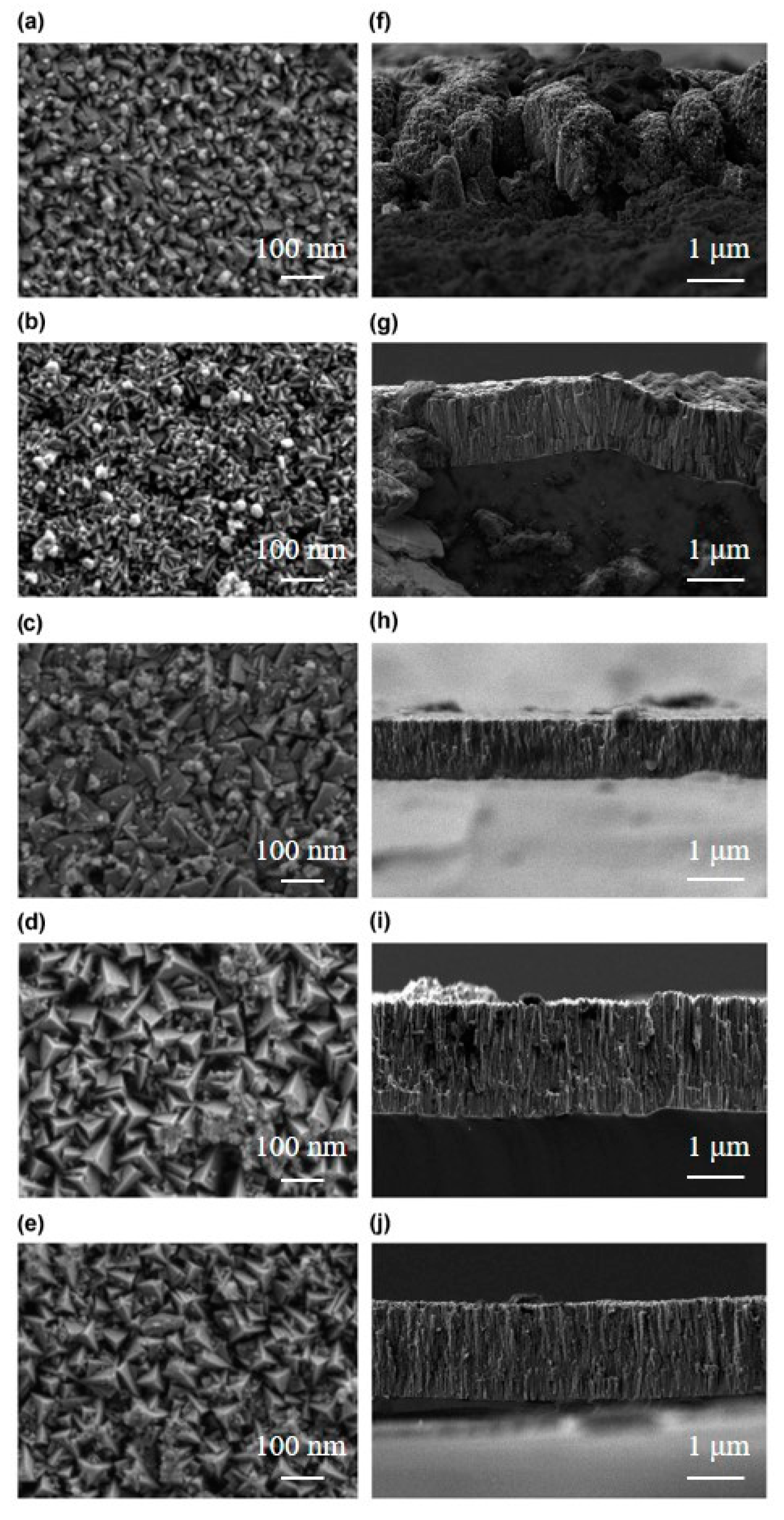
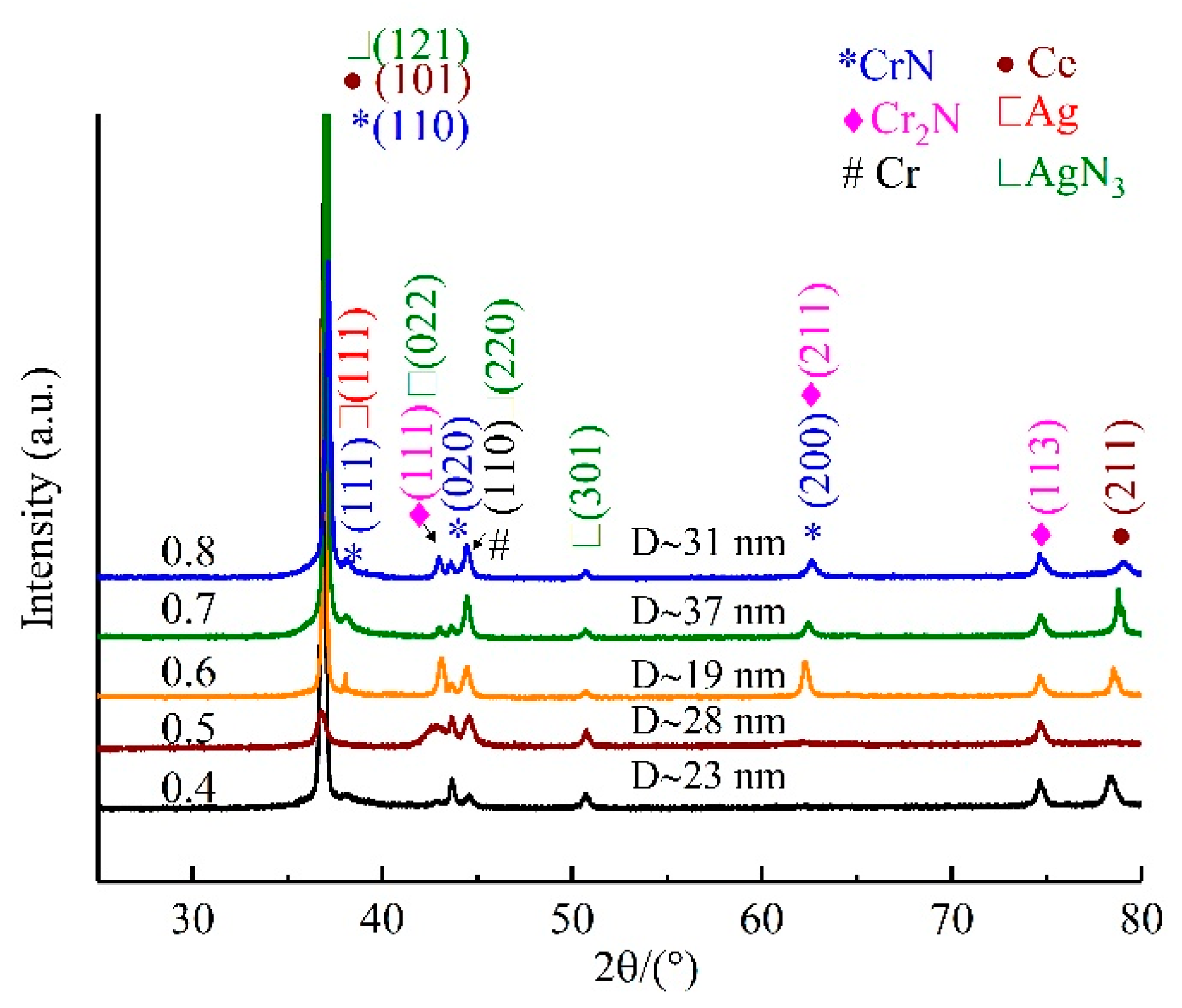


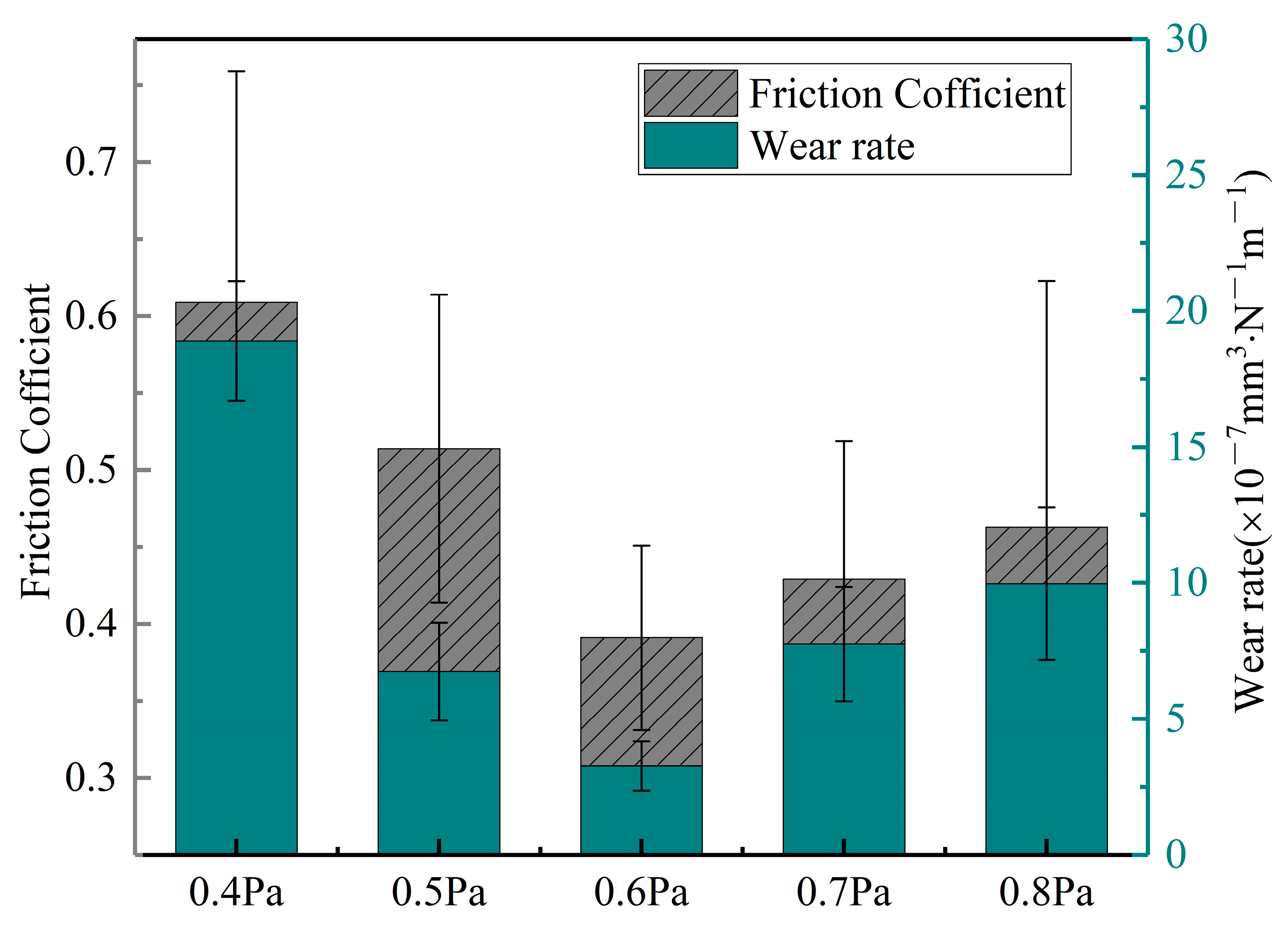
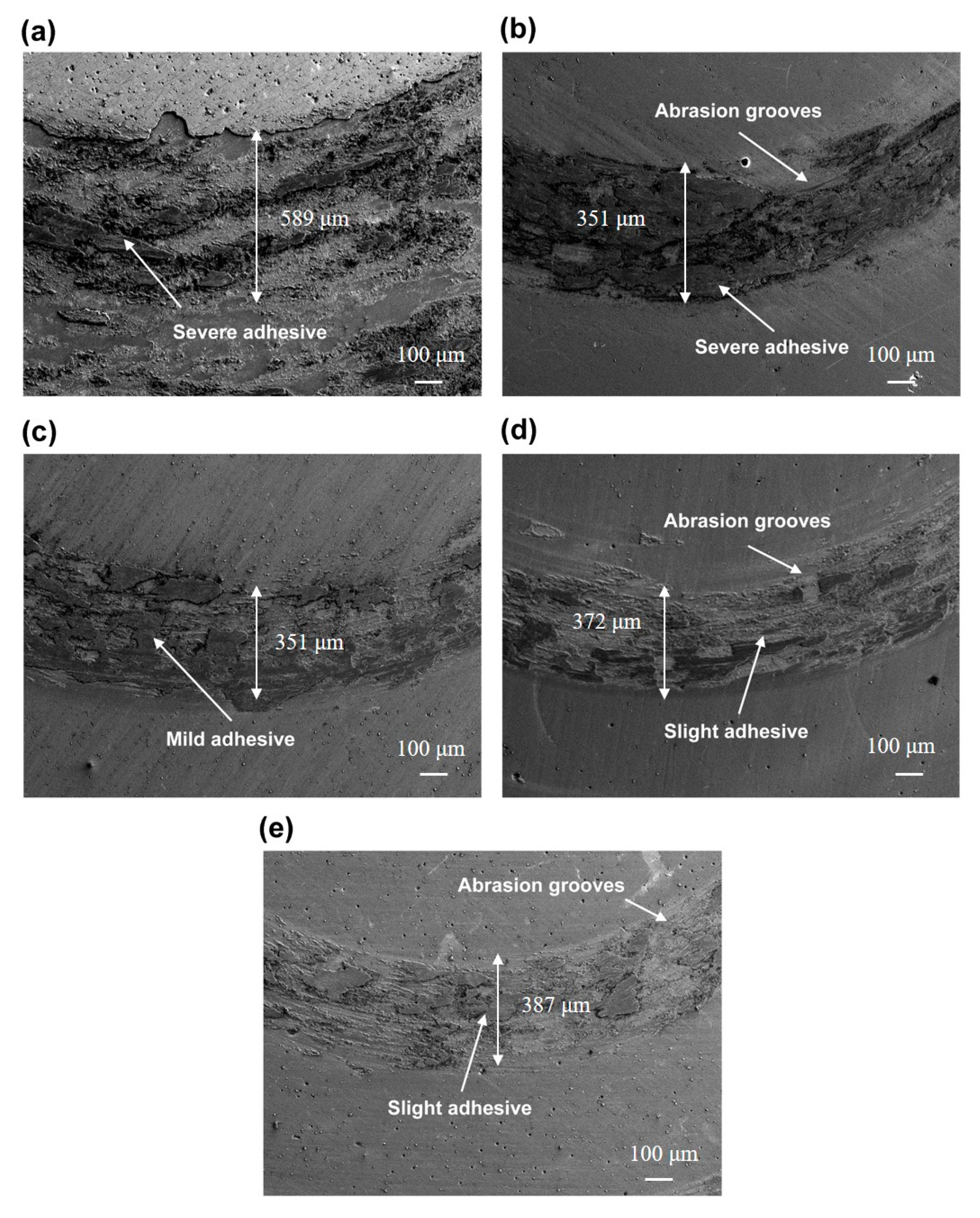
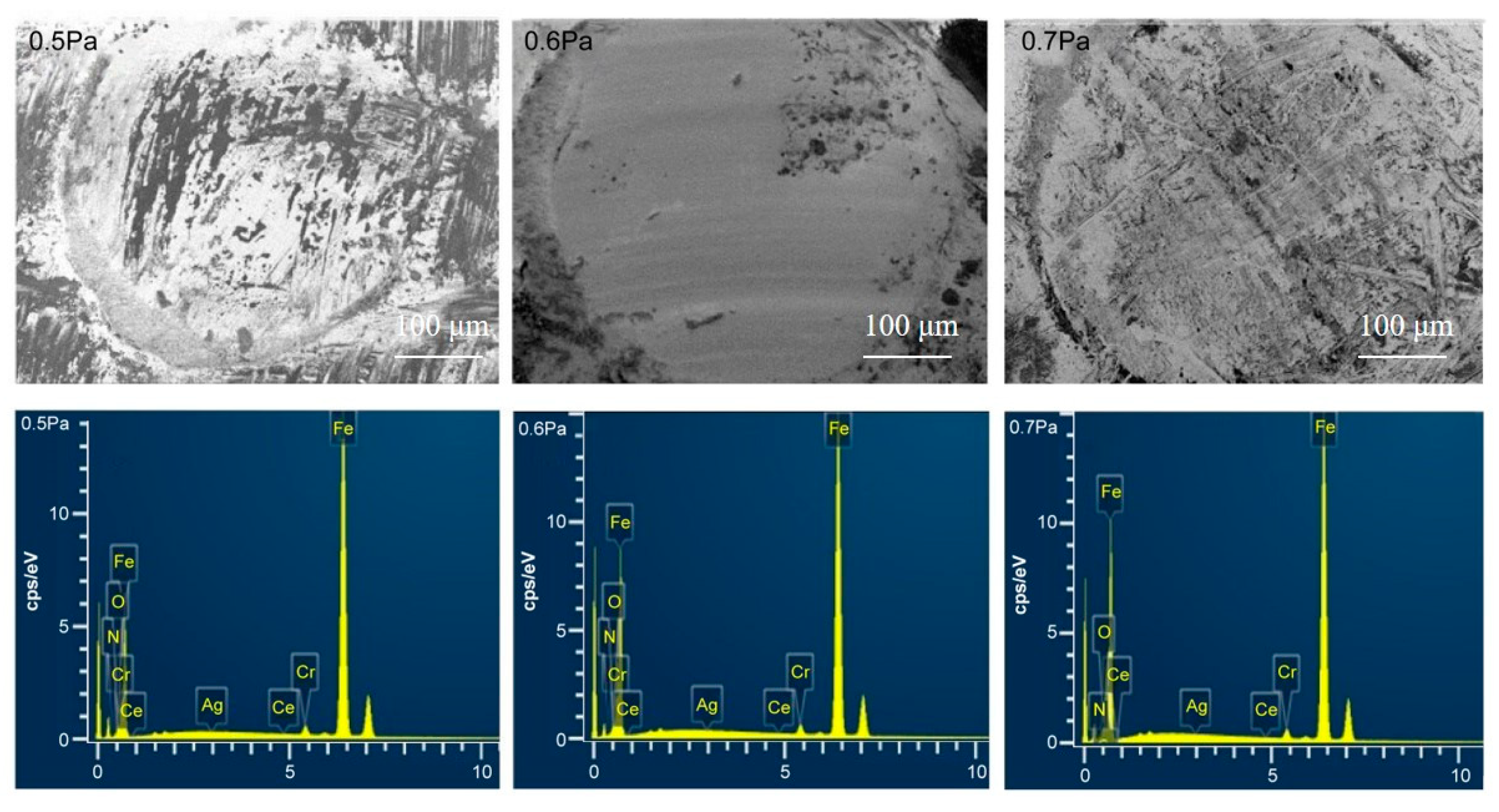
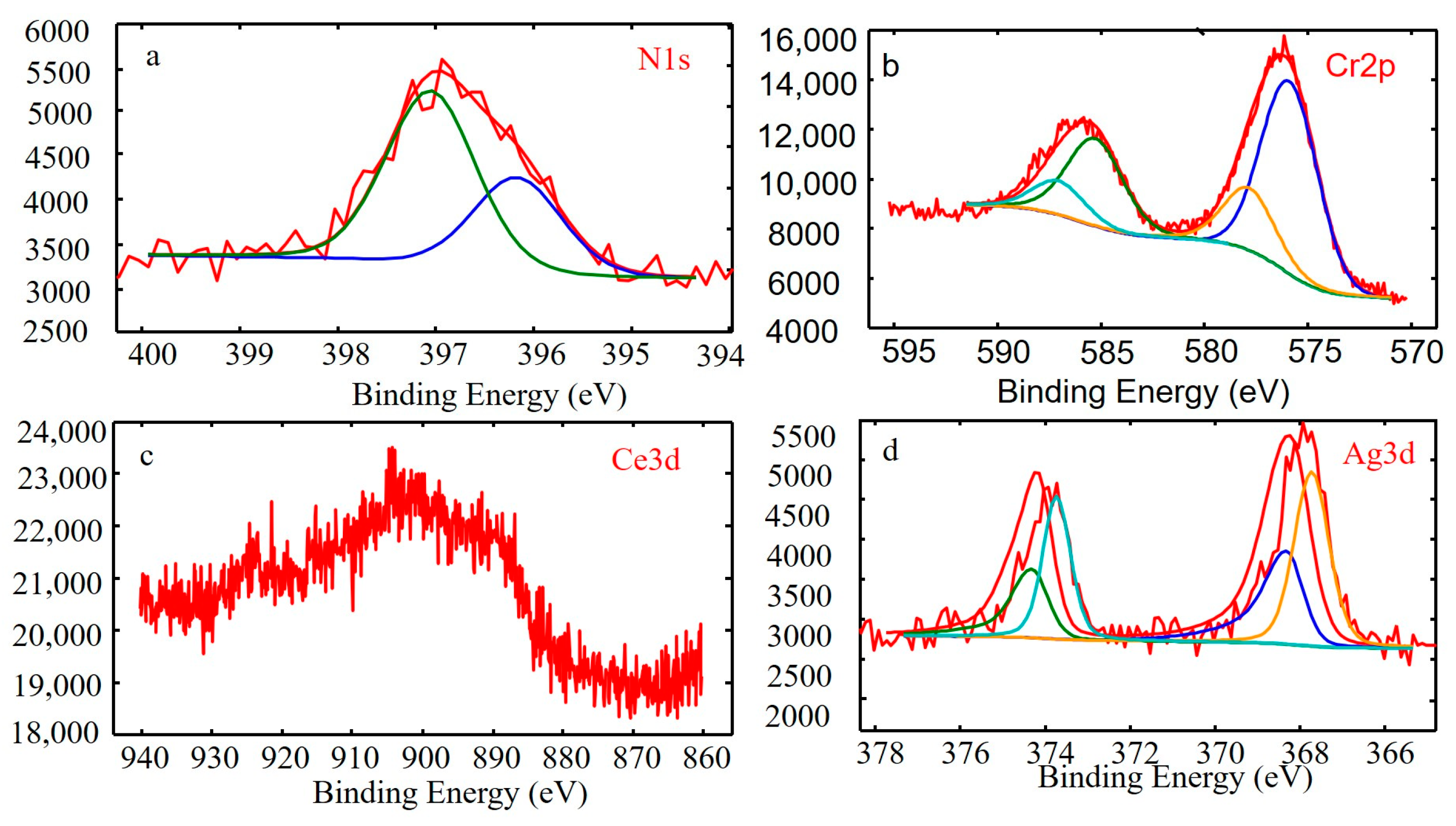
| Deposition Pressure (Pa) | at.-%Cr | at.-% N | at.-% Ce | at.-% Ag | Cr/N | Ce/Ag |
|---|---|---|---|---|---|---|
| 0.4 | 51.1 | 44.2 | 2.5 | 2.2 | 1.16 | 1.14 |
| 0.5 | 51.4 | 44.5 | 2.2 | 1.9 | 1.16 | 1.15 |
| 0.6 | 52.6 | 43.6 | 2.3 | 1.5 | 1.21 | 1.53 |
| 0.7 | 51.5 | 44.1 | 2.2 | 2.2 | 1.17 | 1.00 |
| 0.8 | 50.6 | 45.1 | 2.1 | 2.1 | 1.12 | 1.00 |
Disclaimer/Publisher’s Note: The statements, opinions and data contained in all publications are solely those of the individual author(s) and contributor(s) and not of MDPI and/or the editor(s). MDPI and/or the editor(s) disclaim responsibility for any injury to people or property resulting from any ideas, methods, instructions or products referred to in the content. |
© 2023 by the authors. Licensee MDPI, Basel, Switzerland. This article is an open access article distributed under the terms and conditions of the Creative Commons Attribution (CC BY) license (https://creativecommons.org/licenses/by/4.0/).
Share and Cite
Chang, W.-h.; Cai, H.-c.; Xue, Y.-j.; Lei, X.-q.; Li, H. Effects of Deposition Pressure on the Microstructural and Tribological Properties of CrAgCeN Coatings Prepared by Magnetron Sputtering. Materials 2023, 16, 1141. https://doi.org/10.3390/ma16031141
Chang W-h, Cai H-c, Xue Y-j, Lei X-q, Li H. Effects of Deposition Pressure on the Microstructural and Tribological Properties of CrAgCeN Coatings Prepared by Magnetron Sputtering. Materials. 2023; 16(3):1141. https://doi.org/10.3390/ma16031141
Chicago/Turabian StyleChang, Wei-hang, Hai-chao Cai, Yu-jun Xue, Xian-qing Lei, and Hang Li. 2023. "Effects of Deposition Pressure on the Microstructural and Tribological Properties of CrAgCeN Coatings Prepared by Magnetron Sputtering" Materials 16, no. 3: 1141. https://doi.org/10.3390/ma16031141




